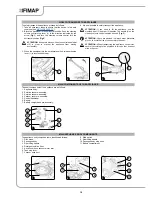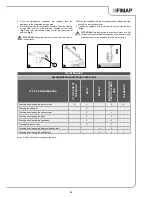
13
BATTERY TYPE
To power the appliance, use only the battery supplied in the package or by a specialised technician.
OTHER BATTERY TYPES CANNOT BE
USED.
The appliance is powered by a lithium-ion battery. The battery compartment can accommodate a single battery slot at 36.5V.
BATTERY MAINTENANCE AND DISPOSAL
For maintenance and recharging, respect the instructions provided
by the battery manufacturer.
THE BATTERY IS CLASSIFIED AS
DANGEROUS WASTE, AND AS SUCH, IT IS COMPULSORY TO
TAKE IT TO AN AUTHORISED SERVICE CENTRE.
For good battery maintenance, follow these indications:
• Do not attempt to open the battery for any reason whatsoever.
Avoid any contact with the liquid that seeps out of damaged
batteries. If necessary, rinse the area of skin which came into
contact with the liquid in water; in case of contact with eyes, rinse
thoroughly and seek medical advice.
• Do not let the battery get dirty or wet.
• The battery must not be exposed to excessive heat (e.g. rays of
sunshine, flames, etc.). Do not leave the battery in places where
the temperature could exceed 40°C.
• The battery contacts must not touch metal parts, to avoid any
risk of short-circuits.
• The battery must be kept far from metal objects, to avoid any risk
of short-circuits.
•
Do not throw the battery into the fire.
• Do not throw the battery away with domestic waste; respect the
disposal regulations in force in the country where the appliance
is used.
For good battery recharger maintenance, follow these indications:
• Always recharge the battery at a room temperature between
10°C and 40°C. Recharge the battery using the power supply unit
supplied with the appliance. Do not attempt to recharge damaged
batteries.
• Only use the power supply unit delivered with the appliance
to recharge the battery supplied by the manufacturer or by a
specialised technician. Other batteries could explode, causing
harm to people and damage to property.
• The voltage rate indicated on the plate in the battery charger must
correspond to the mains voltage.
• Do not use the battery charger in potentially explosive environments.
• The battery charger contacts must not touch metal parts, to avoid
any risk of short-circuits.
• Never attempt to recharge the primary cell batteries: danger of
explosion.
• Never attempt to recharge damaged batteries.
• Every time you want to use the battery charger and the battery,
first make sure they are not damaged. Do not use damaged
appliances. Have faulty parts repaired by the staff of a technical
assistance centre.
• Have any faulty supply wires replaced immediately.
• Do not let the power supply unit get dirty or wet.
• Do not open the power supply unit.
• Do not connect the power supply unit to probes.
• The batteries must be clean and dry when they are inserted in
the battery charger. Do not use the battery charger if the battery
holder support is dirty or wet.
ATTENTION:
the battery charger must only be used in a
covered place.
ATTENTION:
read this manual before using the appliance or
carrying out any maintenance work.
ATTENTION:
if the battery is handled in the wrong way, it
could explode or release acids. This could cause burns and
injuries to the people nearby.
ATTENTION:
when the battery is run down or damaged,
respect the disposal regulations in force in the country of use.
INSERTING THE BATTERY INTO THE APPLIANCE
To insert the battery into the battery holder compartment proceed
as follows:
1. Take all necessary steps to ensure that the device is in a safe
condition (see “
MACHINE SAFETY
’”).
2. Insert the battery (1) in its compartment (2) on the rear left side
of the appliance, making sure the battery poles (3) are facing
towards the upper part of the appliance (
Fig.1
).
3. Press the battery until the clamp (4) is in place (
Fig.2)
.
ATTENTION:
during this process, keep the control handlebar
still, in order to prevent the appliance from moving
accidentally.
2
3
1
4
1
2
3
4
4
5










































